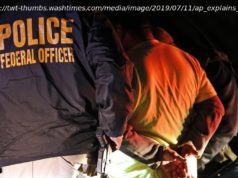Trump hopes the courts will let him detain families like Obama did.
The best way to describe Donald Trump’s current policy toward families crossing the US-Mexico border is this: He just went from being much harsher than Barack Obama, to trying to get the courts to let him be as harsh as Obama was.
The executive order Trump signed yesterday opens the door to him using a tactic Obama used in 2014: the wide-scale detention of immigrant families for as long as it took to complete their immigration cases and deport them.
Comparisons between Trump and Obama on immigration usually focus on deportations of unauthorized immigrants living in the US. Trump has been rapidly expanding enforcement, but the numbers are still comparable to Obama’s first term. (Obama holds the record for deporting more immigrants than any president, with more than 2 million deportations over eight years — though he scaled back enforcement in the last two years of his administration.)
But the effects of the Trump administration’s “zero tolerance” policy for prosecuting illegal entry this spring — the separation of families as a matter of standard government practice for about six weeks, and now (thanks to Trump’s executive order) a coming court fight over the indefinite detention of families seeking asylum — are reminiscent, for those of us who’ve been following immigration for a while, of what the Obama administration did in 2014.
The comparison to Obama’s policies is especially relevant now that the Trump administration is seeking to keep families in immigration detention for weeks or months. The reason that Trump can’t do that under a current judicial order is that the courts stepped in to stop Obama from doing it.
Now Trump is trying to remove the shackles placed on his predecessor.
The most important thing to remember, when we’re comparing Obama’s response to the 2014 border “crisis” to what Trump is doing now, is this chart:
This chart combines two things: the number of people caught crossing into the US between ports of entry (apprehensions) and the number of people who came to ports of entry without immigration papers — for example, to seek asylum (“inadmissibles”). The two lines most likely to jump out at you, each of which represents one fiscal year (October-September instead of January-December), are the blue line that arcs high over the summer months and the orange line that plummets during the winter.
The blue line is 2014 — that’s what Obama was dealing with. The orange line is 2017, when Trump came into office.
Fiscal year 2018 is the red line on the chart. Compared to 2017, it’s a big increase, because 2017 was so anomalously low. But in context, it’s more like a reversion to the norm of the past few years.
It’s worth noting, by the way, that if this chart went back to 2000 or so, the past few years would all look pretty small in terms of border crossings. Unauthorized immigration into the US is still way down from historical levels. That drop has been especially pronounced among single adults coming for work — of the people still coming in, a lot of them are children, families, or other asylum seekers.
Reversion to the Obama-era norm isn’t what the Trump administration wanted, though. The president took a ton of pride in the low number of border crossings in the early months of his term — he kept bragging about it even as apprehensions crept back up in fall of 2017. When he started realizing that people were still coming in to seek asylum, he got upset that the US couldn’t just shut down the border — and pushed into action a policy agenda that would crack down on anyone trying to come to the US without papers, especially if they crossed into the country illegally.
Obama in 2014 took a mostly punitive approach to border crossers . Trump in 2018 took an entirely punitive one. But Obama was reacting partly to circumstances; Trump was reacting solely to his own desires.
Prosecuting people for illegal entry into the US is not new. Illegal entry and illegal reentry have been the two most commonly prosecuted crimes in federal court for years — often via mass trials that basically prosecuted dozens of people at once. Obama didn’t start this trend, but he certainly continued it.
While people charged with illegal entry or reentry made up as much as half of all people prosecuted in federal court in April 2018, they still made up only 10 percent of all people Border Patrol apprehended for crossing into the US between ports of entry.
In other words, officials were still deciding not to prosecute a lot of people — or, at least, didn’t have the resources to prosecute a lot of people and so had to be deliberate in deciding who deserved to be prosecuted. As a general rule — though not always — people who said they feared persecution in their home countries and wanted asylum were not prosecuted. Neither were people who came to the US with their children.
In April 2018, however, Trump’s Justice Department (led by Jeff Sessions) announced that they would start prosecuting every illegal entry case referred to them by the Department of Homeland Security. And in May 2018, Sessions and the Department of Homeland Security announced that they would start referring everyone who entered illegally for prosecution: “zero tolerance.”
The Trump administration isn’t actually prosecuting everyone who crosses the border between ports of entry yet — or even the majority of them. But the implied corollary to the “zero-tolerance” policy was that the Trump administration would no longer make decisions about whom to prosecute based on whether someone was seeking asylum — or whether they were a parent.
That meant that parents were now being referred into the custody of the Department of Justice — while their children were separated from them and reclassified as “unaccompanied minors.”
It’s not that no family was ever separated at the border under the Obama administration. But former Obama administration officials specify that families were separated only in particular circumstances — for instance, if a father was carrying drugs — that went above and beyond a typical case of illegal entry.
We don’t know how often that happened, but we know it was not a widespread or standard practice.
Under the Trump administration, though, it became increasingly common. A test of “zero tolerance” along one sector of the border in summer 2017 led to an unknown number of family separations. Seven hundred families were separated between October 2017 and April 2018.
From May 7 to June 20, separating a family who had entered between ports of entry was the standard practice of the Trump administration. It was the default.
Trump administration officials denied family separation was a “policy” for legalistic reasons, but they affirmed that zero-tolerance prosecutions were a policy. Until Trump signed an executive order on Wednesday allowing families to be kept together in immigration detention while parents were prosecuted, the administration maintained that separating families was an inevitable outcome of prosecuting parents.
Not every family was separated. But dozens of families a day were. At least 2,300 families were separated over those six or so weeks.
We don’t know how many families were separated under the Obama administration, but there’s no reason to believe that it numbered in the thousands even over the eight years that Obama was president. Because it simply wasn’t standard practice. Under Trump, it was.
The 2014 border “surge” was driven partly by an increase in families attempting to cross into the US from Guatemala, Honduras, and El Salvador. But it was primarily driven by an increase in “unaccompanied alien children” — people under 18, coming to the US without parents or guardians — from those same countries.
The federal government had a system to deal with unaccompanied kids, but it was underfunded and overloaded even before the 2014 “surge” — and quickly got backed up. As a result, Border Patrol ended up holding kids for days beyond the 72 hours they were legally supposed to, and the government had to spin up temporary holding shelters for children that looked a lot like jails.






